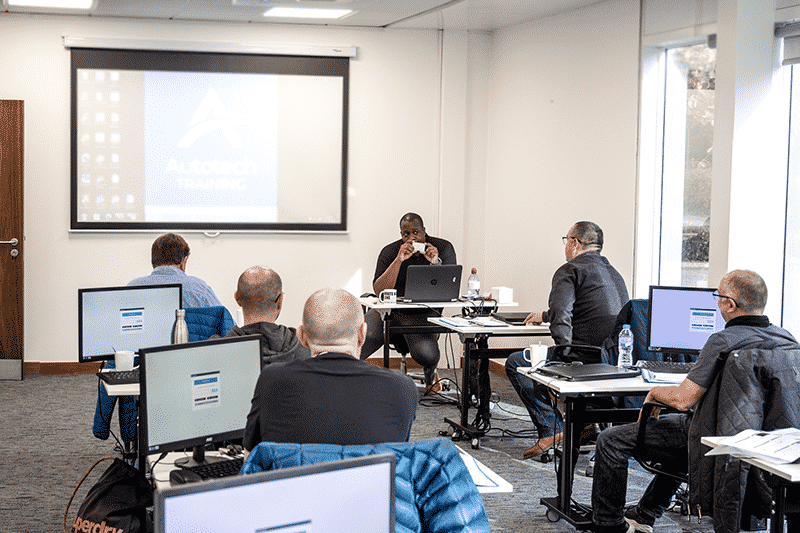Article by Coling Gleghorn, Managing Director of Autotech Training
We have all heard the old fable of two woodcutters named Peter and John... How, to overcome their long running battle over who chopped more wood, they decided to hold a competition to determine the winner. While John doubled his chopping speed and worked relentlessly, Peter took intermittent breaks throughout the day. Feeling close to victory, John was astonished to learn that Peter had defeated him by cutting down more trees. When questioned on how he had accomplished what John deemed to be the impossible, Peter replied: “Well, it’s really simple. Every time I stopped work, while you were still chopping down trees, I was sharpening my axe.”

Now, the morale is clear to you all I’m sure. A small investment can yield significant results. Take the time to invest in yourself and your employees and you’ll achieve far greater results with a lot less effort.
One of the most frequently asked questions, as a director of a training business, is “why invest in people, they’ll just ask for more money and then probably leave?”. My answer has been the same for over 20 years, “if you don’t invest, they will definitely leave”. A small investment can yield significant results. Take the time to invest in yourself and your employees and you’ll achieve far greater results with a lot less effort.
5 PRINCIPLES OF STEPPED PROCESS THAT WILL HELP YOUR TEAM GAIN THE MOST FROM TRAINING
1. Prior to attendance, explain to the attendee what the benefit to their role will be by participating in the training event
2. Give them set objectives to realise from the course
3. De-brief them as soon as they return
4. Revisit the training material regularly during the days and weeks post-attendance
5. Ensure the attendee has the ability to share the newfound skills across their respective work colleagues and thus create a better collective way of working
Developing and retaining your key assets is not optional
In the same way as you wash your used cars on a sales forecourt, you accept the cost for cleaning. Indeed you budget for maintenance and repairs of said used cars because you know they are more likely to sell and turn a profit if they are presented well. So, why would you question the continual development of the people who are the face of your business and charged to deliver on your brand message? Especially as we are working within an industry which is evolving at such a rapid pace.
Taking a more strategic view of training will help bring about a culture of people development and retention across your workforce. Plan your training, look at alternative methods of delivery, measure effectiveness and include staff retention as one of your KPIs.
Of course, training takes the form of many guises, I am a true advocate of mentoring, in-house guidance and using successful practitioners will accelerate acceptance of new processes or methods of operating if it is sponsored by people of influence from within the workforce. I will come back to this later.
Understanding the principle that “qualification is for some; application is for all” is important. We all want to progress, and while some are studious, many others are practical learners - the challenge is to cater for both as their careers develop.
Bite-sized learning
The use of bite-sized learning is seen as most preferable, not just following the change in learning bought about because of the global pandemic, this approach has actually been the most preferred method of learning by institutions for many years now. We have long since realised that people learn at different rates, so it is our direct responsibility to offer solutions accordingly, and this is where bite-sized learning really has become so successful.
We all use YouTube, Dailymotion or Vimeo to research our first ‘how’ thoughts or challenges, and there is plenty of data surrounding video length and engagement. While there is evidence to support the fact that videos between 6 and 12 minutes will engage a viewer as they have committed to the time to watch, around two minutes seems to be the sweet point. Therefore, it’s important to offer training solutions that are selectable, easy to digest, and ultimately provide the learner with the information necessary to check or improve their way of working.
After a long career in the British army I am reminded, sometime too often, that discipline and SOPs (Standardised Operating Procedures) have their place, but I will never forget to make learning fun.
I love to watch the faces of training participants change as they relax and become more receptive to the messages being conveyed. The moment they realise the subject relates to them, that it’s going to help them do their job a bit better, then half the battle is won, thereby making the whole learning experience a positive one, both for delegates and the trainer.
Having a great instructor who understands this is hugely important
A good trainer will incorporate short quizzes, use pre-course work, reward positive comments throughout the training and ensure key messages are emphasised and summarised before departing. Everyone should also be given a take-home guide towards the practical use of the learning material for the job function back at work.
All of which brings us back nicely to retaining good people. Our research suggests, using skilled training experts, be it from within the workforce or from a specialist training organisation, will ensure skills are retained and utilised within a business for a lot longer than if training was put low down on the priorities list.
I referred earlier on the importance of investing in people. If you have well trained and motivated staff delivering on the customer promise, taking challenges in their stride, surrounded by likeminded colleagues always looking for a better way to deliver excellence, your investment will be repaid time and time again.
Every successful team has an ethos of togetherness, the team must have a great leader, and I truly believe it is they who create loyalty and retention of the staff members.
I wish you every success with the creation of just such an environment for today and tomorrow. As the late Captain Sir Tom Moore said, ‘Tomorrow will be a good day’.

